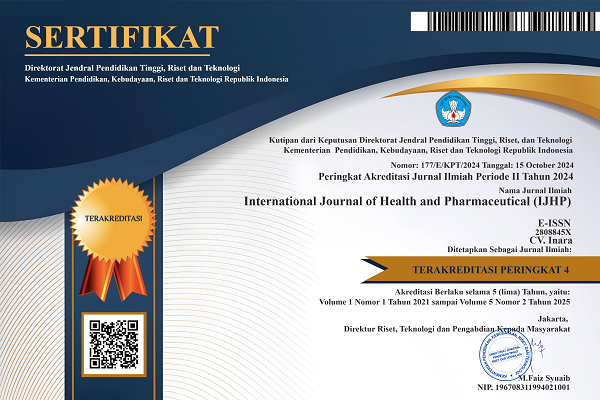Anti-Inflammatory Effect Of Carica Papaya Leaves Extract In Male Wistar Rats Based On Variation Of Concentration
DOI:
https://doi.org/10.51601/ijhp.v4i3.279Abstract
Treatment of inflammation is currently dominated by using synthetic drugs, which if used in cases of chronic inflammation such as hyperuricemia and rheumatoid arthritis will carry the risk of increasing side effects for the user. Papaya leaves as a potential herb in some communities are also used as a treatment for inflammatory conditions. The aim of this research was to determine the anti-inflammatory effect of papaya leaf extract in vivo based on variations in concentration in Wistar white rats. This research is an in vivo study using 25 male Wistar Rats and divided into 5 groups. Group I was given as a negative control (P0), the group used Diclofenac Sodium as a positive control (P1), the Carica papaya leaf extract test group with varying concentrations of 40% (P2), 50% (P3), and 60% concentration (P4). Carrageenan 1% is used as an inflammation inducer. The inflammation observation parameter in this study was the volume of edema in the rats' feet at 30 minute intervals for 180 minutes. The average percentage reduction in edema during 180 minutes of observation in the P2, P3 and P4 extract test groups was 81.00%, 78.33% and 81.00%, respectively. The positive control group (P1) showed a reduction of 81.66%, while the negative control was only 26%. The results of statistical tests show that there is an effect of giving the extract on reducing edema in mice compared to the negative control group. From these results it can be concluded that the ethanol extract of Carica papaya leaves with concentrations of 40%, 50% and 60% showed an anti-inflammatory effect on male Wistar rats.
Downloads
References
D. Murugesan and R. Deviponnuswamy, “Potential Anti-Inflammatory Medicinal Plants-A Review,” 2014.
C.-C. Szeto et al., “Non-Steroidal Anti-Inflammatory Drug (NSAID) Therapy In Patients With Hypertension, Cardiovascular, Renal Or Gastrointestinal Comorbidities,” Gut, vol. 69, no. 4, p. 617, Apr. 2020, doi: 10.1136/gutjnl-2019-319300.
J. W. Weick, H. S. Bawa, and D. R. Dirschl, “Hyaluronic Acid Injections for Treatment of Advanced Osteoarthritis of the Knee: Utilization and Cost in a National Population Sample,” JBJS, vol. 98, no. 17, 2016,
B. N. Lindler, K. E. Long, N. A. Taylor, and W. Lei, “Use of Herbal Medications for Treatment of Osteoarthritis and Rheumatoid Arthritis,” Medicines, vol. 7, no. 11, p. 67, Oct. 2020, doi: 10.3390/medicines7110067.
A. H. Al-Nadaf and A. Awadallah, “Evaluation for the level of knowledge about herbal medicine use within people and university students in Mutah region,” Pharmacia, vol. 67, no. 4, pp. 397–403, 2020, doi: 10.3897/pharmacia.67.e59319.
A. Adel, M. Elnaggar, E. Al-Sayed, and M. Rabeh, “Secondary Metabolites from Carica papaya, and its Biological Activities: A Comprehensive Review,” Archives of Pharmaceutical Sciences Ain Shams University, vol. 5, no. 2, pp. 331–353, Dec. 2021, doi: 10.21608/aps.2021.106355.1073.
I. T. Marlinawati, B. A. Sc, S. Santoso, and Y. Irwanto, “The Effect of Papaya Leaf Extract Gel (Carica papaya) on Interleukin-1β Expression and Collagen Density (Col1A1) in the Back Incision Wound Healing of Wistar Rats (Rattus norvegicus),” 2023.
Y. R. Kong et al., “Beneficial role of Carica papaya extracts and phytochemicals on oxidative stress and related diseases: A mini review,” Biology, vol. 10, no. 4. MDPI AG, Apr. 01, 2021. doi: 10.3390/biology10040287.
G. N. Kumar, M. P. Maran, and S. R. Shankar, “Mineral composition, Antioxidant and Anti-inflammatory Activities of the Crude Extract of Leaves of Carica papaya L,” 2021.
S. Pandey, P. J. Cabot, P. N. Shaw, and A. K. Hewavitharana, “Anti-inflammatory and immunomodulatory properties of Carica papaya,” Journal of Immunotoxicology, vol. 13, no. 4. Taylor and Francis Ltd, pp. 590–602, Jul. 03, 2016. doi: 10.3109/1547691X.2016.1149528.
Dit. Produksi dan Distribusi Kefarmasian, “Farmakope Herbal Indonesia,” Jakarta, 2017.
W. Samosir and S. Syarifuddin, “Anti-Inflammatory Effect Of Leaf Ethanol Extract Of Cat’s Kumize (Orthosiphon Stamineus Benth) In Male White Rats Of Wistar Strains,” Medalion Journal, vol. 1, no. 3, 2020, doi: https://doi.org/10.59733/medalion.v1i3.54.
C. A. Winter, E. A. Risley, and G. W. Nuss, “Carrageenin-Induced Edema in Hind Paw of the Rat as an Assay for Antiinflammatory Drugs,” Proceedings of the Society for Experimental Biology and Medicine, vol. 111, no. 3, pp. 544–547, Dec. 1962, doi: 10.3181/00379727-111-27849.
H. S. Semis, C. Gur, M. Ileriturk, O. Kaynar, and F. M. Kandemir, “Investigation of the anti-inflammatory effects of caffeic acid phenethyl ester in a model of λ-Carrageenan–induced paw edema in rats,” Hum Exp Toxicol, vol. 40, no. 12_suppl, pp. S721–S738, Dec. 2021, doi: 10.1177/09603271211054436.
S. Subramanian Iyer and G. Cheng, “Role of Interleukin 10 Transcriptional Regulation in Inflammation and Autoimmune Disease,” 2012.
Z. You et al., “Pro- and anti-inflammatory cytokines expression in rat’s brain and spleen exposed to chronic mild stress: Involvement in depression,” Behavioural Brain Research, vol. 225, no. 1, pp. 135–141, 2011, doi: https://doi.org/10.1016/j.bbr.2011.07.006.
N. G et al., “Phytochemical Analysis And Antioxidant Properties Of Leaf Extracts Of Carica papaya,” Asian Journal of Pharmaceutical and Clinical Research, pp. 58–62, Nov. 2020, doi: 10.22159/ajpcr.2020.v13i11.38956.
Downloads
Published
Issue
Section
License
Copyright (c) 2024 Vonna Aulianshah, Yelda Ratu Thaharah, Noni Zakiah, Rini Handayani

This work is licensed under a Creative Commons Attribution-NonCommercial 4.0 International License.























